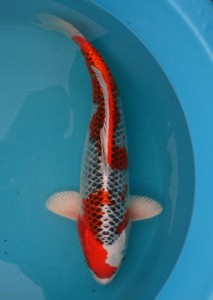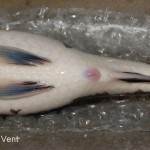How to determine the sex of koi fish is a frequently asked question that is difficult to answer. Even an expert with a trained eye can miss the physical distinctions. Ordinarily it isn’t until the koi is sexually mature (1-4 years or over 12 inches long), when the differences become more apparent. Here are some telltale signs that your koi is a male or female.
Physical Characteristics Determining the Sex of Koi Fish
Size and Skin Texture
Females are typically larger than males. However, this is only a good means of spotting the difference if you know that the koi are a similar age.
At around two years old, males will develop white growths (known as tubercules) during the mating season and start to feel gritty, almost like sandpaper on the gill plates and dorsal regions. Not to worry, though. These white growths don’t denote illness and will disappear once spawning is over. Females, delicate as always, will continue to feel smooth to the touch.
Shape
Body


Mature females will have larger midsections and appear rounder in the middle (often described as “blimp shaped”) as a result of egg production. Males, without the ability to produce eggs, will appear more streamlined and torpedo shaped.
Fins
The difference in fin shape between the sexes is very slight. In males, the pectoral fins are generally more pointed (or diamond shaped) while the female pectoral fins are usually more rounded. The color opacity is higher in males, too, whereas females’ fins are more transparent.
Vent


Located on the underside of the koi, the vent is a key physical trait that can distinguish male from female. The male’s vent is more sunken and concave. The female vent is convex, and more protruding. It is also different color (pinkish in appearance).
While the body and fin shapes can help identify the gender, they are not definitive. The best way to identify the gender is the appearance of the vent and to feel for the presence of eggs in the abdomen.
Other Differentiating Characteristics
Behavior
During mating season, behavior will also change and is a good way to help determine the sex of koi fish. In much the same fashion as most of the animal kingdom, males will chase females, offering a nudge of encouragement to release their eggs.
Feeding habits
Males tend to dart to the surface and then arrow back down, whereas females will take somewhat measured approaches. This is a general rule, however, as different categories of koi will exhibit different behaviors when you ring the dinner bell.
Be it male Sanke or female Shusui—and many other types of koi in between—Next Day Koi has an impressive selection of available koi fish for sale. Contact us to see how we can help to leverage some of the of the most competitive Next Day Air shipping rates in the industry, to get your quality koi into your pond or tank in no time at all.

Can you put all in one pond with different species?
Yes, different varieties of koi can all live in the same pond together.
Sure, but no telling what the baby koi will look like.
Is it true you can tell the sex of your koi by the dorsal fin? The male has a Bonnie like front of the dorsal, and the female doesn’t!?
While this is true, the sexing of koi by dorsal fin is not 100% accurate. It is still best to use several methods together to determine the gender.
I would like to buy my butterfly koi by sex. Is there any way this can be done. I want one male and one female
Hi Katherine,
Yes, we do occasionally list some of our Koi and Butterfly Koi by sex. You may view our current listings via the link provided below.
https://nextdaykoi.com/koi-fish/koi/
From a computer, please kindly use the filtering tool on the left-hand side of the screen to filter only Male and Female fish.
Thank you.